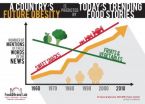Endangered and elusive species by definition may be both rare and difficult to locate. As a result, conservation geneticists typically have to rely on sources of DNA collected non-invasively, such as from hair, feathers or feces. Up until now, these approaches have been quite successful in obtaining genetic information from a handful of markers across the genome. However, so-called 'next-generation DNA sequencing' (NGS) now allows researchers to collect massive volumes of genetic data on the scale of entire genomes, yet the necessary requirements for harnessing such technology may not be available in most cases for endangered species. For example, NGS typically requires high quality and large quantities of starting DNA extracted from fresh tissues or blood. Acquiring such materials is trivial for humans; a mere cheek swab will usually do. This is not the case, say, for the Amur leopard, which is both rare and elusive. In such cases, scientists and managers must rely on non-invasively collected sources of DNA that typically yield low quality and low quantity of starting material.
The new study published in the open access journal PeerJ by researchers at the University of British Columbia (UBC) and SNPsaurus LLC demonstrates that the non-invasive sampling that is essential for many conservation-related studies is now compatible with the minimum requirements for harnessing NGS technologies. As a result, it will now be possible to further expand the field of conservation genetics in the genomics era.
"We were able to collect genome-wide data from natural populations of the elusive and climate-sensitive American pika on a scale unheard of just a few years ago" says Dr. Michael Russello, an Associate Professor at UBC and principal investigator of the study. The innovative data collection approach pioneered by Dr. Eric Johnson and Dr. Paul Etter of SNPsaurus LLC, both co-authors of the study, enabled the sampling of almost 10,000 variable sites in the American pika genome using, in some cases, as little as 1 nanogram (one billionth of a gram) of starting DNA extracted from hair. "There are tremendous benefits for expanding our coverage of the genome when studying species of conservation concern, as it vastly improves our inferences of key genetic characteristics of populations and opens up new avenues for inquiry in the form of potentially identifying those parts of the genome that are involved in organisms' ability to adapt to changing environments" adds Dr. Russello. The use of NGS on non-invasively collected samples is not without its challenges, but can be overcome with a host of careful considerations pointed out by the authors.
In an era in which global biodiversity continues to decline at rates consistent with a mass extinction, conservation scientists and managers can now add genomics to their toolkit for attempting to document and reverse this trend.
INFORMATION:
EMBARGOED until July 21st 2015: 7 am EDT; 11 am GMT (i.e. the date of publication)
PDF of this Press Release: http://static.peerj.com/pressReleases/2015/PressReleasePeerJ_Russello.pdf
Zip file of High Resolution Images: http://static.peerj.com/pressReleases/2015/1106_images.zip
Link to the Published Version of the article (quote this link in your story - the link will ONLY work after the embargo lifts): https://peerj.com/articles/1106 - your readers will be able to freely access this article at this URL.
Citation to the article: Russello et al. (2015), From promise to practice: pairing non-invasive sampling with genomics in conservation. PeerJ 3:e1106; DOI 10.7717/peerj.1106
Competing Interests statement from the article: "Paul D. Etter is the Director of Research and Eric A. Johnson is the founder of SNPsaurus, an organization that offers commercial nextRAD sequencing services. This organization provided no funding for this project."
Peer Review History: The peer-review history of this article will be made public at the time of publication. To access the review history before publication email press@peerj.com
About PeerJ:
PeerJ is an Open Access publisher of peer reviewed articles, which offers researchers a lifetime publication plan, for a single low price, providing them with the ability to openly publish all future articles for free. PeerJ is based in San Francisco, CA and London, UK and can be accessed at https://peerj.com/. PeerJ's mission is to help the world efficiently publish its knowledge.
All works published in PeerJ are Open Access and published using a Creative Commons license (CC-BY 4.0). Everything is immediately available--to read, download, redistribute, include in databases and otherwise use--without cost to anyone, anywhere, subject only to the condition that the original authors and source are properly attributed.
PeerJ has an Editorial Board of over 1,000 respected academics, including 5 Nobel Laureates. PeerJ was the recipient of the 2013 ALPSP Award for Publishing Innovation.
PeerJ Media Resources (including logos) can be found at: https://peerj.com/about/press/
Media Contacts
For the authors: Michael Russello, email: michael.russello@ubc.ca, Phone: +1 250 807 8762 (Canada)
For PeerJ: email: press@peerj.com , https://peerj.com/about/press/
Note: If you would like to join the PeerJ Press Release list, visit: http://bit.ly/PressList
Abstract (from the article):
Conservation genomics has become an increasingly popular term, yet it remains unclear whether the non-invasive sampling that is essential for many conservation-related studies is compatible with the minimum requirements for harnessing next-generation sequencing technologies. Here, we evaluated the feasibility of using genotyping-by-sequencing of non-invasively collected hair samples to simultaneously identify and genotype single nucleotide polymorphisms (SNPs) in a climate-sensitive mammal, the American pika (Ochotona princeps).We identified and genotyped 3,803 high-confidence SNPs across eight sites distributed along two elevational transects using starting DNA amounts as low as 1 ng. Fifty-five outlier loci were detected as candidate gene regions under divergent selection, constituting potential targets for future validation. Genome-wide estimates of gene diversity significantly and positively correlated with elevation across both transects, with all low elevation sites exhibiting significant heterozygote deficit likely due to inbreeding. More broadly, our results highlight a range of issues that must be considered when pairing genomic data collection with non-invasive sampling, particularly related to field sampling protocols for minimizing exogenous DNA, data collection strategies and quality control steps for enhancing target organism yield, and analytical approaches for maximizing cost-effectiveness and information content of recovered genomic data.


